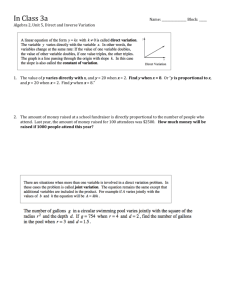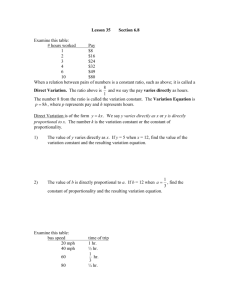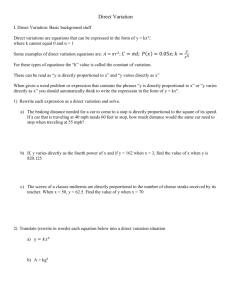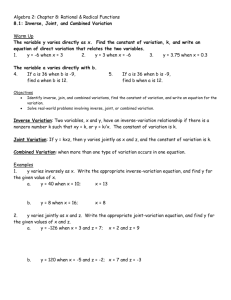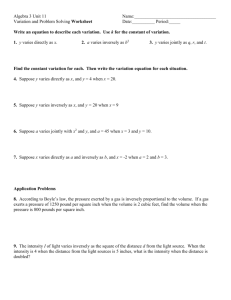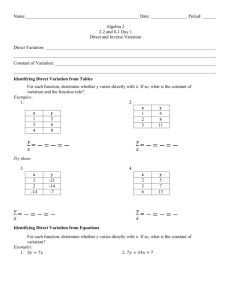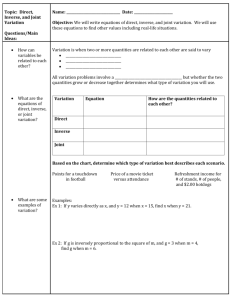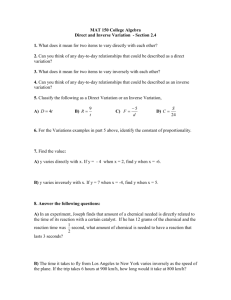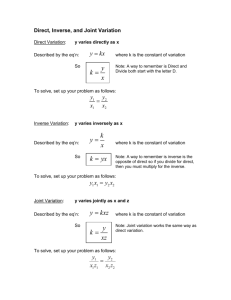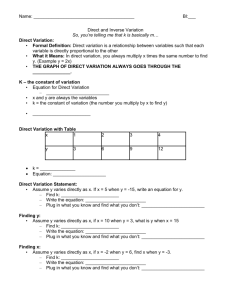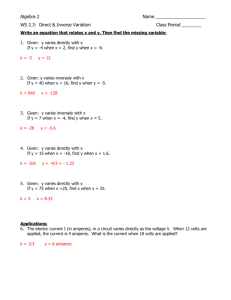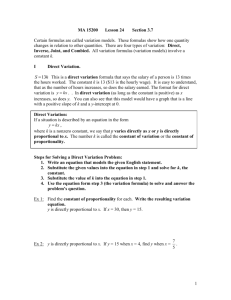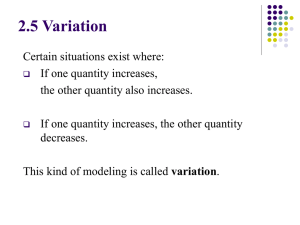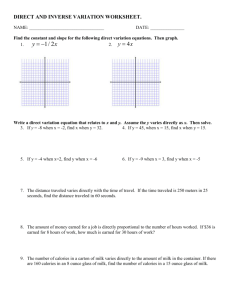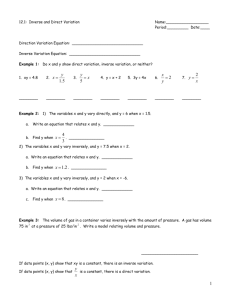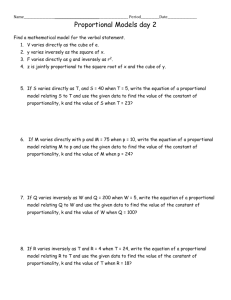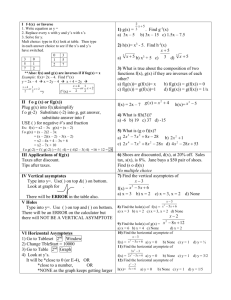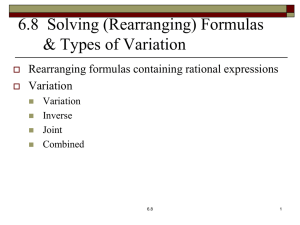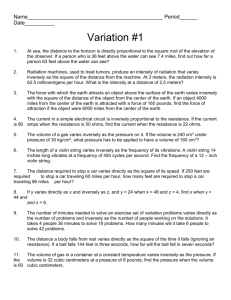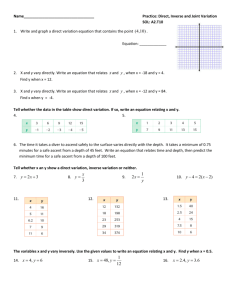Lesson 34
advertisement
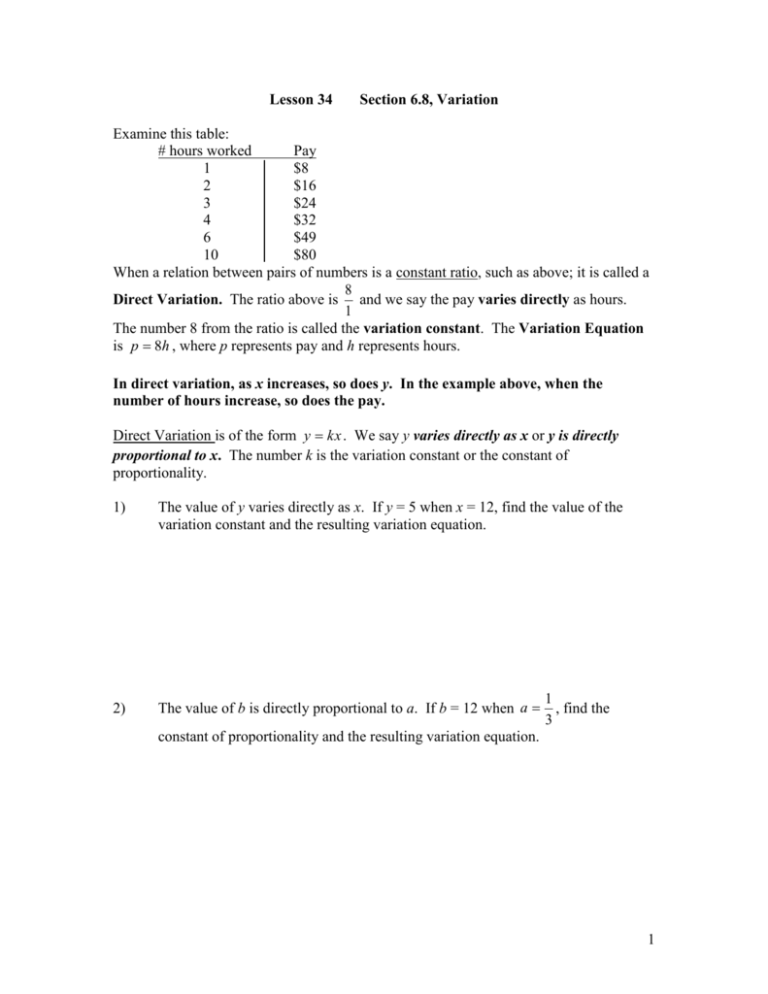
Lesson 34 Section 6.8, Variation Examine this table: # hours worked Pay 1 $8 2 $16 3 $24 4 $32 6 $49 10 $80 When a relation between pairs of numbers is a constant ratio, such as above; it is called a 8 Direct Variation. The ratio above is and we say the pay varies directly as hours. 1 The number 8 from the ratio is called the variation constant. The Variation Equation is p 8h , where p represents pay and h represents hours. In direct variation, as x increases, so does y. In the example above, when the number of hours increase, so does the pay. Direct Variation is of the form y kx . We say y varies directly as x or y is directly proportional to x. The number k is the variation constant or the constant of proportionality. 1) The value of y varies directly as x. If y = 5 when x = 12, find the value of the variation constant and the resulting variation equation. 2) The value of b is directly proportional to a. If b = 12 when a 1 , find the 3 constant of proportionality and the resulting variation equation. 1 Examine this table: bus speed 20 mph 40 mph time of trip 1 hr. ½ hr. 1 60 mph hr. 3 80 mph ¼ hr. When a relation between pairs of numbers is such that the product of the numbers remains constant, such as the table above (product is 20), it represents Inverse Variation. 20 The product 20 represents the variation constant and the inverse variation is t , r where t represents time and r represent speed. In inverse variation, as x increases, y decreases (or as x decreases, y increases). In the example above, as the rate of the bus increases, the time decreases. k . We say y varies inversely as x or y is inversely x proportional to x. The number k is still the variation constant or the constant of proportionality. Inverse Variation is of the form y 3) Suppose y varies inversely as x. If y = 16 when x = 4, find the variation constant and the resulting variation equation. 4) Let n be inversely proportional to m. Suppose n = 81 when m = 4. Find the constant of proportionality and the resulting variation equation. 2 Joint Variation is of the form y kxz . Combined Variation is of the form y k x kx or . z z 5) Suppose y varies jointly as x and z. a) If y = 6 when x = 12 and z = 4, find the variation constant and the resulting variation equation. b) Use your equation to find the value of y when x = 3 and z = 4. 6) Let y vary jointly as x and z and inversely as w. 1 a) If y = 20 when x = 2, z = , and w = 10, find the variation constant and 2 the resulting variation equation. b) Find the value of y if x = 4, z = 0.6, and w = 0.3. 3 7) Suppose y varies directly as the square of x and inversely as the square root of z. a) If y = 12 when x = 3 and z = 16, find the value of the variation constant and the resulting equation. b) Find the value of y if x = 2 and z = 9. 8) The time T required to do a job varies inversely as the number of people P working. It takes 5 hours for 7 volunteers to pick up trash from 1 mile of a highway. How long would it take 10 volunteers to complete the job? 9) The electric current I, in amps, in a circuit varies directly as the voltage V. When 16 volts are applied, the current is 5 amps. What is the current when 20 volts are applied? 4 10) The stopping distance d of a car (in feet) after the brakes have been applied varies directly as the square of the speed r. Once the brakes are applied, a car traveling 60 miles per hour can stop in 138 feet. What stopping distance corresponds to a speed of 40 mph? 5
